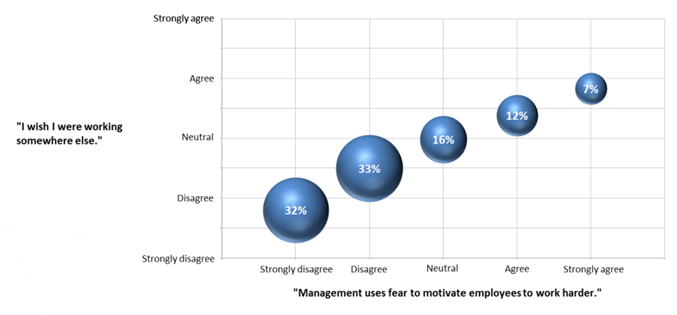A Lesson in Leadership from Downton Abbey
Jan 06, 2016
Written by: Mark Hirschfeld
(View Author Bio)


There’s a charming scene in an episode of Downton Abbey where Violet Crawley, the character played beautifully by Dame Maggie Smith, has a “coaching moment” with one of her employees. The employee had been spreading rumors of a possible staff reduction at the great manor house. The hurtful gossip came to the attention of Lady Crawley, who deftly exposed her employee in the presence of a guest in a way that sent shivers down the spine of the rumor-mongering underling.
After the staff member was excused, her guest inquired about the bit of drama for which she was an unwitting participant. Lady Crawley responded: “Sometimes it’s good to rule by fear.”
This makes for terrific television, and it raises an interesting question that is relevant to managing employees-- is fear a tool that can be used to motivate employees today?
Maybe.
Fear can motivate employees. Many a time have managers ended a command to an employee with an implied or explicit “or else”. The consequences are clearly understood—do this or you may lose privileges or an opportunity for a promotion or even loss of employment. The “or else” can cause anxiety in the employee to whom the message is directed, and the employee can channel that anxiety into greater energy toward completing a task.
So managers may congratulate themselves on getting a short-term result, meeting a deadline perhaps, by using fear. Maggie Smith’s character would be proud.
But is there a cost?
In his book Widgets, Rodd Wagner shows the cost-benefit ratio of using fear to motivate is, at best, quite thin:
“So why do powerful people use fear? Because in the short term and in limited ways, it works. Of course you can scare someone into doing what you want. People work harder on both ends of the intimidation scale than they do in the middle. But there are vast differences between working hard voluntarily and doing so because you are freaking out. Fearful employees scramble to find ways to improve the way they work, to cover their butts, but the drive is not as strong, as effective, or as honest as among those who are fearless. One set of experiments found that people experiencing anxiety are more likely to engage in “self-interested unethical behaviors” and to rationalize their misconduct as not as serious as similar acts by others.”
When you put it that way, maybe fear isn’t the best tool to use in the 21st Century. In the case of Mrs. Crawley, we would suggest that there are other ways, better ways, to deal with less-than-desirable behaviors such as an employee needlessly stirring the pot with rumors.
And if you want some data to support my point, here’s what our latest research into the New Rules of Engagement® shows regarding how fear impacts employee engagement, this case the desire of an employee to stay:

How can you reduce fear in your place of work? Consider:
- How much fear are employees experiencing?
- What’s the source?
- What’s its toll?
- What can we legitimately do to reduce it?
- What will get in the way of us making meaningful progress?
Don’t be a Violet Crawley. Enough, already, with the fear tactics! Rather, find ways to inspire and excite your team about what you’re doing and where you’re going. Your team members deserve better.
Take a few minutes and learn about your level of engagement and happiness at work by completing our confidential assessment. Let us know what you think!











